Revealing The Secrets of Review Request Emails
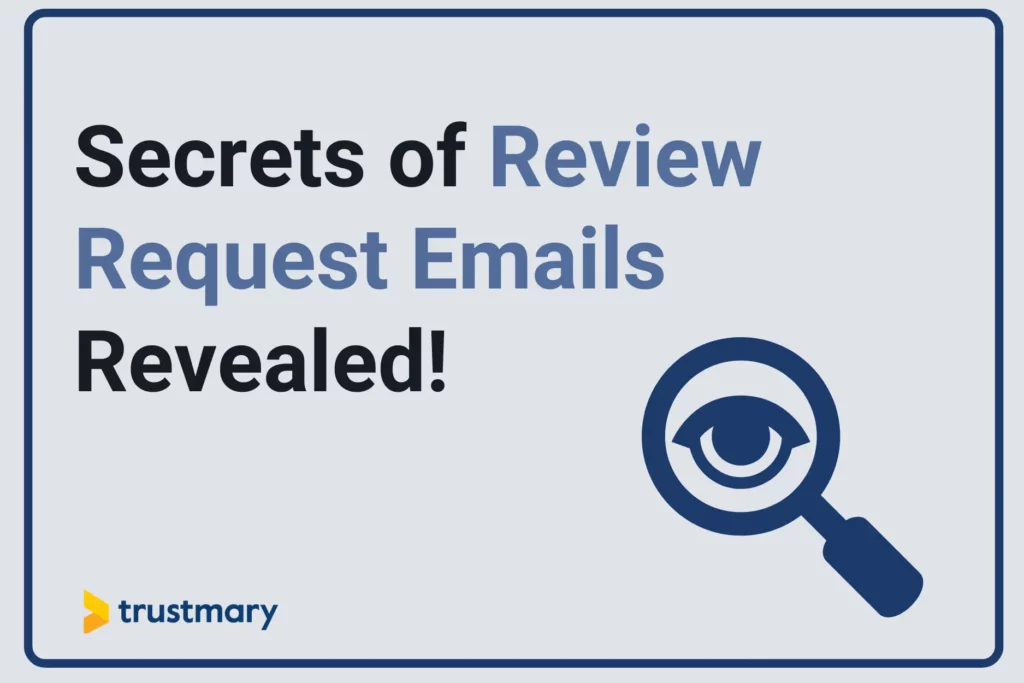
Emails are an effective medium for gathering customer feedback and making the most of your marketing efforts.
Positive reviews help to build social proof and brand trust.
These then influence the purchasing decisions of other potential customers.
In other words, if you’re not asking for product reviews in emails, you’re missing out. In this article, you’ll learn everything you need to know to generate post-purchase reviews via email.
What Are Review Request Emails?
Review request emails, also called product review emails, are emails sent to gather feedback after customers purchase a product or service.
The email can contain the feedback form or can include links to third-party sites where the email recipient can leave the review.
Examples of these third-party sites include Google My Business, Yelp, Capterra, and G2.
Do bear in mind that just sending a Google review link to customers might result in bad customer experience, because not everyone has a Google account nor is signed into it all the time. If that's the case, they'll click on your link as see this:
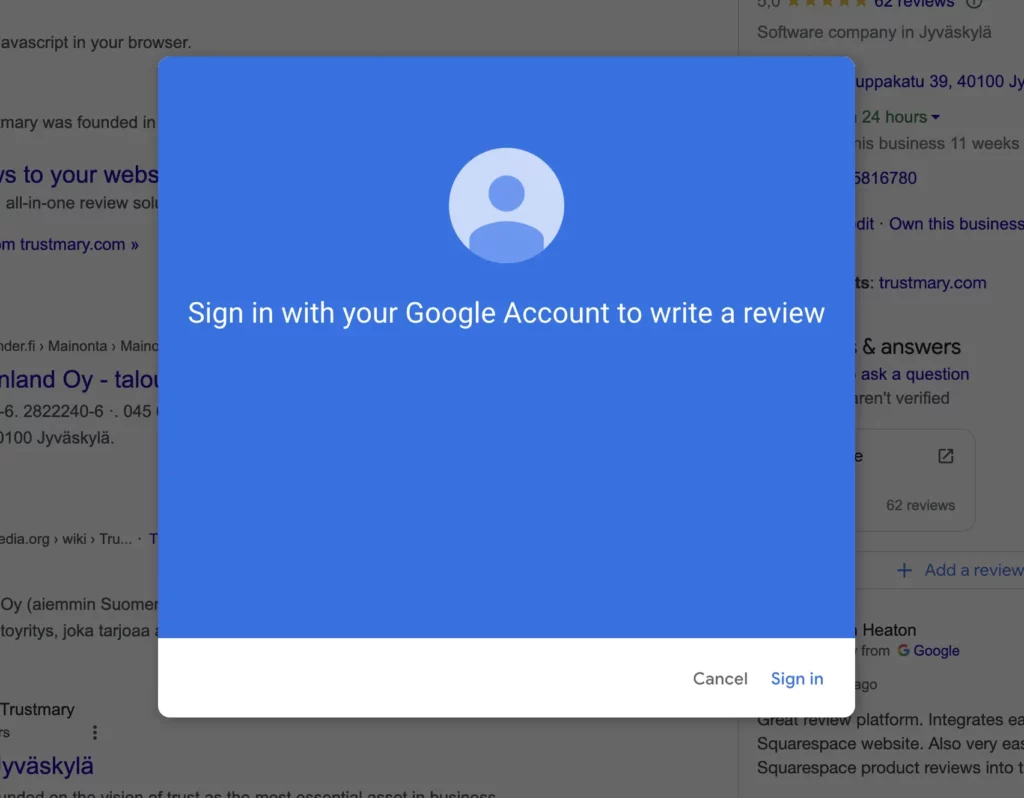
To avoid this, first ask for feedback that doesn't require people to sign in, and then ask if they'd like to leave a review.
You can also use review request emails to gather details about your customer’s experience with your brand as a whole.
Usually, product review emails are automated and are triggered after a customer makes a purchase. Depending on the product or service, product review emails may be sent a short while or days after the customer buys from you. We’ll talk more about this in the next section.
Succeeding with Online Review Requests
After analyzing data from Trustmary users in 2024 I uncovered the winning formula – Trustmary Method.
Results speak for themselves:
- Email open rate is 40%
- 65% of email openers leave feedback
- 32% respondents leave a review
That makes the average review rate 20-30%!
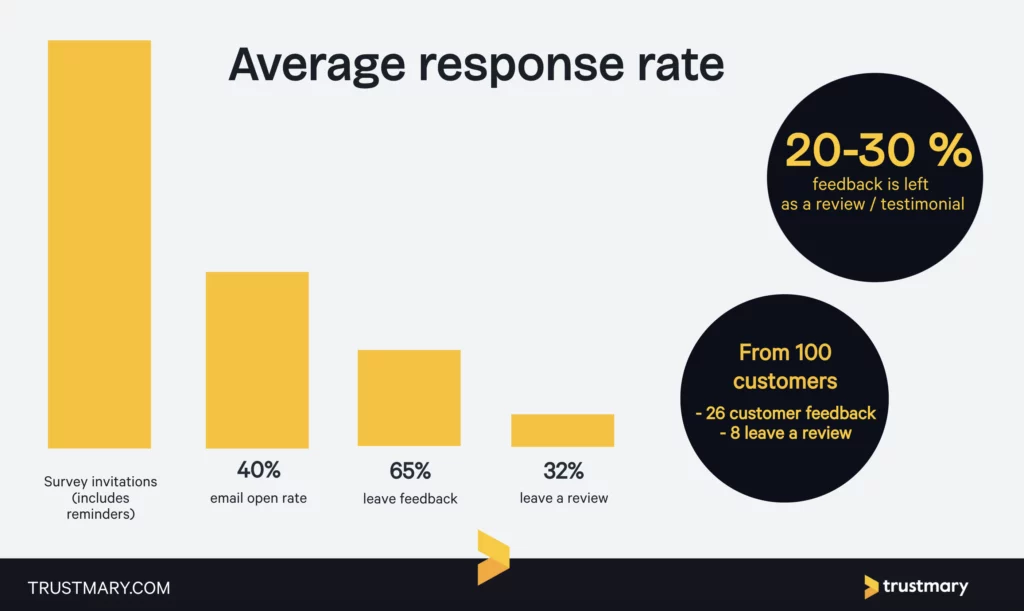
The real trick is not to go straight for the review request, but ask for customer feedback first.
I'm not talking about review gating, but changing the context of the ask.
Instead of going "Hey, review us", it's better to be humble and say "Hey, and thanks for being our customer. Tell us how we've been able to serve you".
That opens the dialogue, and you can THEN ask if the customer would like to provide the feedback publicly.
How many reviews would you have, if you could turn even 20% of your positive feedback into reviews?
When to Request Reviews
It’s important to know when to ask your customers for reviews.
Your timing can affect the quality and quantity of the feedback you receive, after all. If you request a review right after a customer has made a purchase, they may not have enough time to fully experience the product or service. This could result in a less informed and less detailed review.
On the other hand, if you wait too long to request a review, the customer may have forgotten about their experience or may have lost interest in leaving a review altogether.
The exact period to ask customers for reviews will vary based on the type of product. For example, if you run a restaurant, you can send a product review email a few hours after purchase. If you’re asking them to review an online tool, send the email after a week or so. You want to make sure your customer already used the product before they give you their feedback.
In general, though, the best times to send your product review emails are between 2 to 3 p.m. and 6 to 7 p.m.
But that’s not a hard-and-fast rule. Look at your email analytics to determine when customers are likely to engage with your emails. That’s when you should send your request.
As a final tip, you need to ensure your emails will reach your intended recipients.
Many email finder tools come with verification features that help you purge your contact list of wrong entries. Use these tools to your advantage.
Benefits of Review Request Emails
Sending review request emails offers clear benefits.
According to Statista, nearly 70% of online shoppers typically read between one and six customer reviews before making a purchase decision.
The opinions of real people who have used your products serve as social proof. They can be the nudge other consumers need to make a purchase.
Also, sending review request emails can help you engage with your customers and encourage them to become more involved with your business. Your customers are more likely to trust your brand if you value their feedback.
Through review request emails, you can also identify the areas of improvement for your product or service.
Now that you know the benefits of review request emails, let’s look at how you can ask for them.
Pre-Email Preparation
You should determine where you want your email recipients to leave their reviews in the first place.
This will help determine your email structure.
Do you want them to send their reviews directly so you can import them to your website? In this case, you’d need to incorporate a feedback form into your email.
Trustmary can help you create these testimonial forms.
You can customize
- the font
- color
- language, and
- fields in the forms.
You can create the forms easily, whether you’re asking for a written or a video review.
Your customers can answer the forms easily, too. Then with Trustmary, you can add these collected reviews to your website.
One way to boost response rates is to embed a survey in email.
This way, the first click is already an answer!
You can also ask your email recipients to leave their reviews on third-party seller sites. In this case, you’d need to include a link to Yelp, Google My Business, Capterra, or G2 in your email. The link should lead them to your specific page, not the homepage. If you make them search for your page after they click on the link, they aren’t likely to take your desired action.
The good thing about reviews on these sites is that they are more likely to appear when people search for your business on Google (assuming your business is listed on Google My Business). Check this example of Google reviews on Sixth City Marketing’s page.
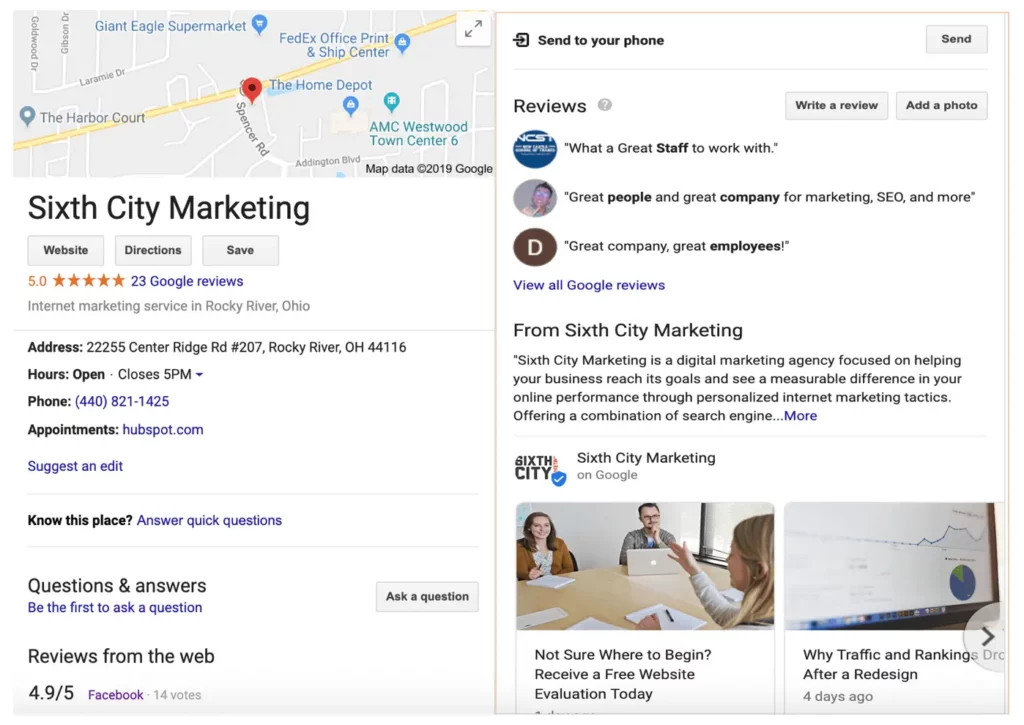
(Source)
Once your customers are on these sites, use a tool like Trustmary to import them to your website.
Email Content
When creating a review request email, there are several do’s and don’ts you should follow.
A personalized review request email can also go a long way in making your customers feel special. Use a strong subject line that can catch the reader’s attention. Through generative AI, you can get the best subject lines based on your email copy. This can help ensure your emails are opened in the first place.
In your email body, don’t ask your email recipients for the review from the get-go. You have to thank your customer for buying from you first.
A thank you note shows that you value their patronage. It can be vital to building a strong relationship with your customer.
Also, don’t assume your customers know what they just bought from you. In your email, you should specifically mention the product or service they purchased. For example, say, “Thank you for using our xxx” instead of “Thank you for your purchase.”
This adds a personal touch to the email content. At the same time, you’re telling your email recipient what you’d like their review to be about.
When writing your product review emails, maintain a pleasant and professional tone. Check out this great example:
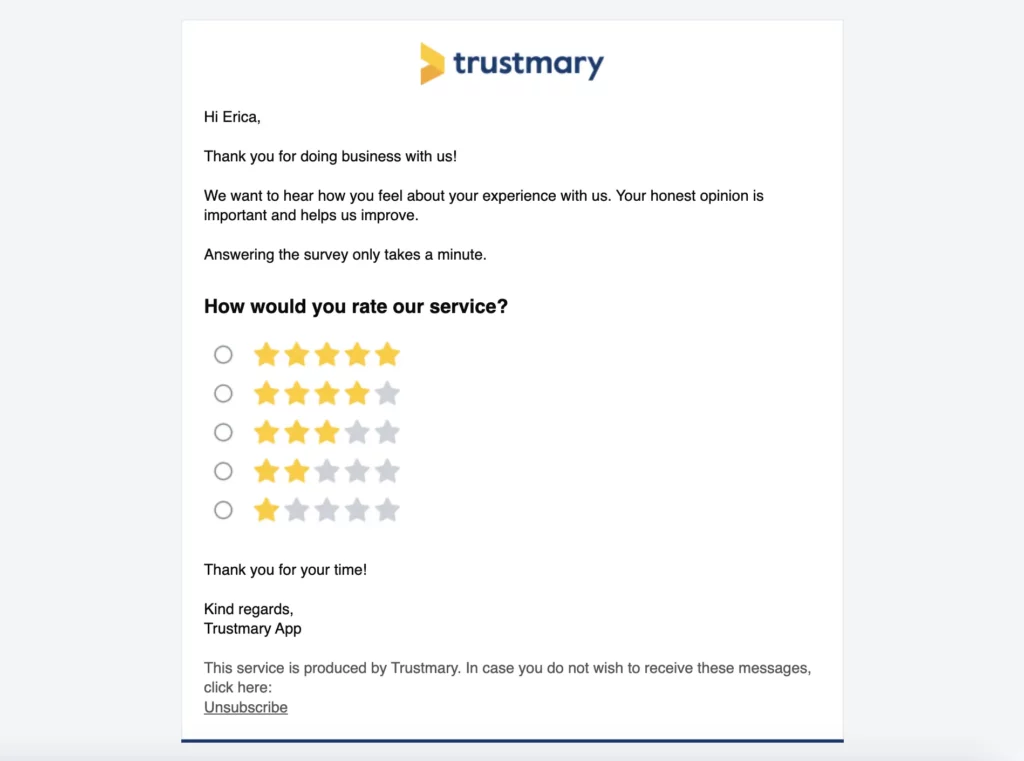
It’s not pushy. Instead, the brand creates a safe space for the customer to leave honest feedback.
Create yours now and collect reviews either directly to Google or to Trustmary. Start collecting Google reviews by searching your Google Business location below ⬇️ ⬇️
Remind the customer of the benefits of leaving a review in your email. Explain why customer feedback is valuable. That might just be what they need to leave one in the first place.
In the example above, Glenview Smiles emphasizes that the feedback “helps us to improve our ability to provide you with the best dental care possible.” See how the brand highlights the benefit to the email recipient, not just the benefit to the brand.
Don’t forget to leave clear instructions in the body of the email. What exactly should your email recipient do to leave the review?
It follows then, that you should also include a clear call to action. But don’t just include any CTA. As with social media advertising, SaaS content production, and email marketing, your CTA should be compelling and actionable.
Check out this review request email from Airbnb. It’s easy to understand. The email recipient knows exactly what will happen once they click on the CTA button.
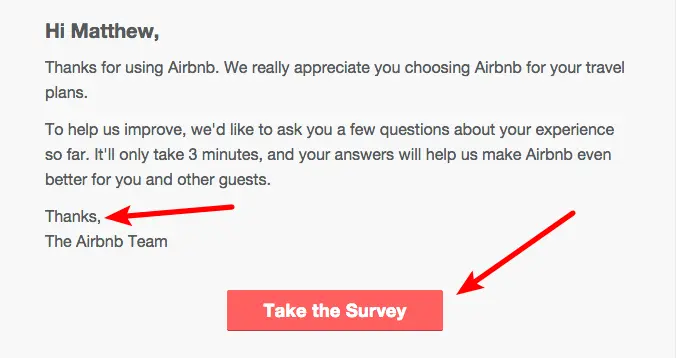
(Source)
As Airbnb reviews are important, they're a built-in feature in using Airbnb.
Don’t forget to thank your customer at the end of your email.
That should be in your product review emails even if your customer doesn’t leave you feedback. After all, they still took the time to read your review.
Post-Email Follow-Up
Let’s face it. You probably won’t get a response to your email the first time you send it. That’s why you need to send a follow-up email. A follow-up email can increase the reply rate from 9% to 13%.
You can add incentives or discounts to motivate your customers to leave a review. Incentives or discounts don’t just make it more likely for people to leave feedback. They also make your customers stay loyal to your brand. Who doesn’t want a freebie, after all?
If your customer did leave a review after your first email, you should still send them a separate email thanking them for it. Appreciate the customer for taking the time to give the feedback, like Gartner Peer Insights did in the email below. This will also go a long way in helping you get more product or service reviews in the future.
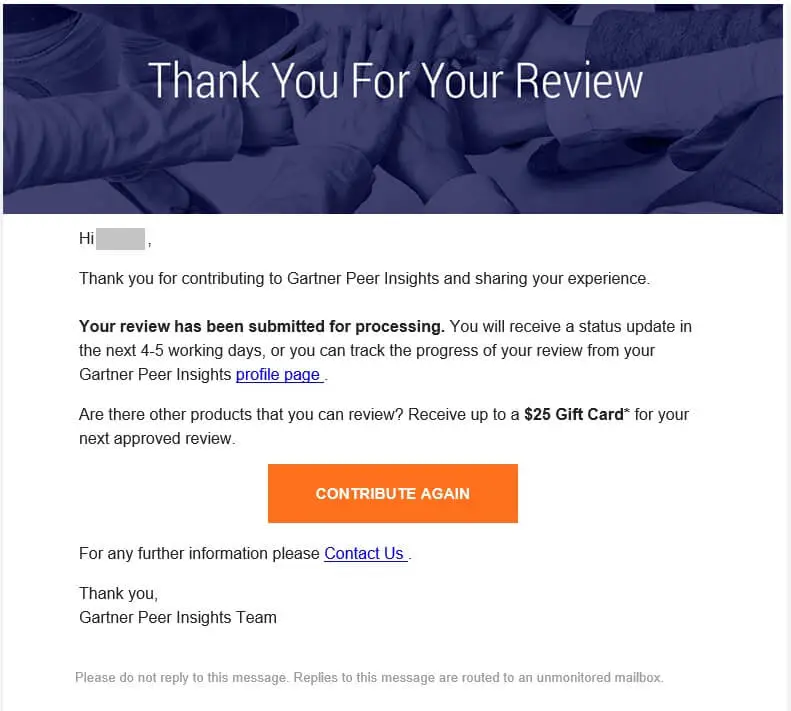
(Source)
If the customer left a positive review, appreciate them for finding your product or service valuable. A simple, “we are glad you liked xxx” can help you nurture vital relationships with your customers. They are also more likely to spread the good word about your brand. The result? More customers (and hopefully more good feedback) for you.
While bad reviews could be disappointing, don’t respond negatively or lash out. Instead, you should investigate why the customer has dropped a bad review.
Show empathy and offer to talk more about why the customer isn’t satisfied with your product or service. Send them another email for this.
Responding to negative reviews professionally shows that you care about your customers’ opinions. According to research by Brightlocal, 88% of consumers are likely to use a business if they can see the business owner responds to all reviews, whether positive or negative.
Besides, both positive and negative reviews can yield information you can use to improve your products or services.
Other Review Request Email Examples
We’ve already given some examples of emails that illustrate some of our points. But just so you have more product review emails for inspiration, here are two more.
This Oz Hair and Beauty email is ideal because it thanks the customer for making a purchase. The email recipient doesn’t have to guess the product the company needs them to review. After all, the email states what the product purchased by the email recipient was.
The email also asks for a review in a polite manner. It even motivates the recipient to leave a review with its discount offer:
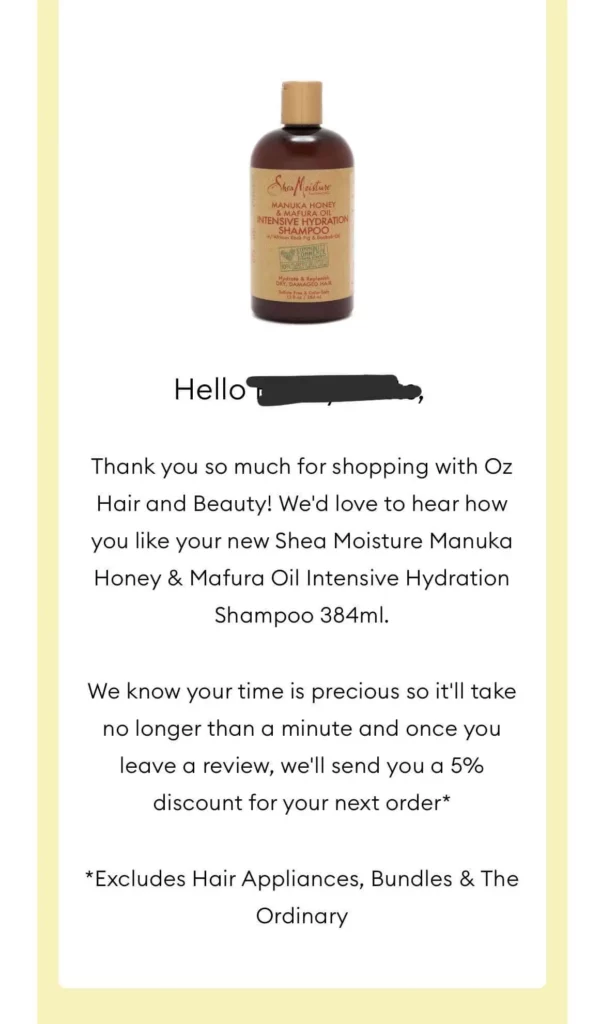
Now here’s an example of a service review request email:
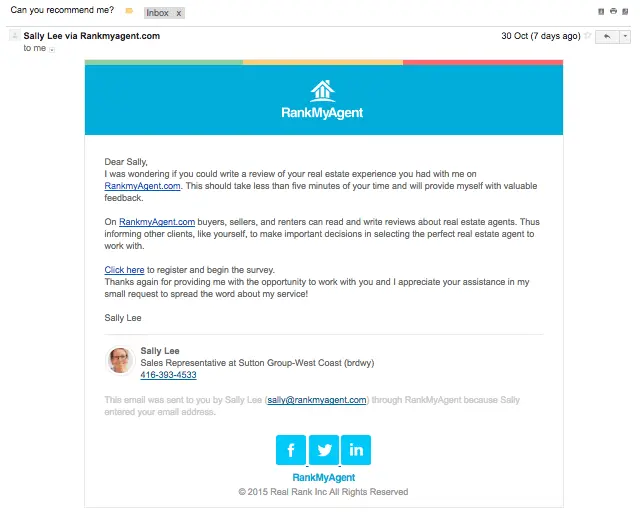
(Source)
It’s a great example because it’s personalized. It also includes a clear call to action so the email recipient knows exactly how to leave the review.
The thank-you note is worth highlighting, too.
In Closing
Customer reviews are vital to building social proof and brand trust. Product review emails are great for gathering feedback after customers make a purchase.
To prepare an effective review request email, you must choose the right platform for your reviews. Don’t forget to personalize your content, specify the product to be reviewed, and mention the benefits customers can derive from leaving reviews. Offer incentives if you can, and leave a clear call to action. Make sure you send your follow-up email, too.
Product review emails are critical to your brand’s success. Use them to your advantage.
Trustmary is the easiest tool for collecting and displaying your reviews. Sign up from the link below:
FAQ
No, asking customers for positive reviews directly is not ethical. Rather, you should ask for honest feedback and use it to improve your business. However, you can encourage customers to leave an honest review by offering incentives and expressing gratitude for any feedback they offer.
How can I track the success of my review request campaign?
To track the success of your review request campaign, track metrics like the open rate, conversion rate, click-through rates, and review scores.
How many review request emails should I send?
The number will vary based on your business and industry. However, you shouldn’t overburden your customers by asking for reviews daily. A good rule of thumb is to ask for one review per purchase / service, and add one reminder message after a few days. If you have a longer relationship with the customer, a quarterly or yearly review can be enough.
The article was written in collaboration with David Campbell from Ramp Ventures.
